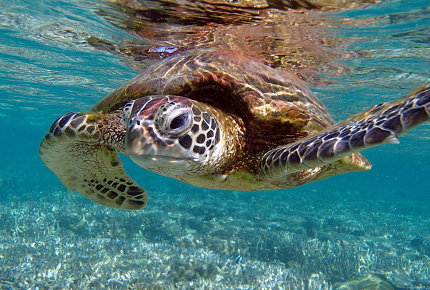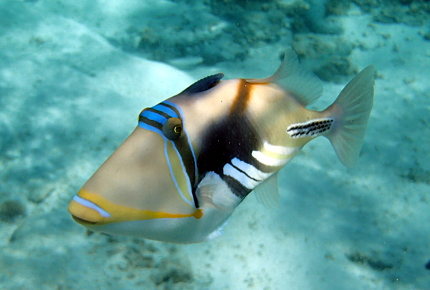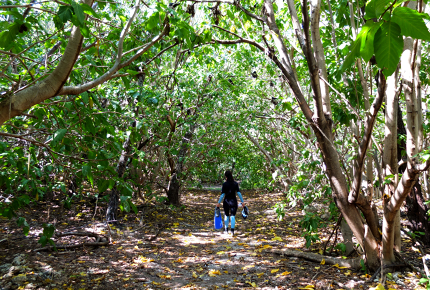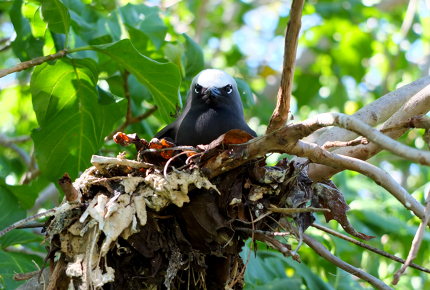Castaway on Lady Elliot Island, Australia
Basking near Australia’s continental shelf, Marie Barbieri loses herself among marine creatures of all colours and contours on Lady Elliot Island.
I sharply inhale and halt dead still - or as still as one can hover atop a swaying reef. A majestic four-metre beauty arcs up and we clock eyes. It’s love at first snorkel with a manta ray.
He’s enjoying a body scrub, courtesy of a bluestreak cleaner wrasse that nibbles the attached parasites. This giant black and white kite tangos with the swell, its implausibly placed eyes holding the stare. We share a magical 10 minutes together, until he breaks off the affair.
Lady Elliot Island, located between Fraser Island and Lady Musgrave Island off the east coast of Australia, is the resident home of the Manta alfredi. Due to its isolation (80km/49 miles northeast of Bundaberg), it claims some of the most limpid waters of the Great Barrier Reef.
 A green sea turtle graces the lagoon
A green sea turtle graces the lagoonLady Elliot Island
The glorious, paradisiacal island was actually built by poo (guano, to be precise), courtesy of excreting seabirds that fertilised and seeded the isolated cay.
In 1863, however, it was almost stripped of its vegetative richness. Around 30 Asian miners arrived to pillage Lady Elliot for her guano. Settlers deforested the island, sparing just eight pisonia trees. They dug the topsoil and sold 20,000 tonnes of guano as gunpowder and fertilizer to Sydney and London.
Roll on 1969, when visionary pilot Don Adams arrived, bringing with him native shrubs and seeds for re-vegetation. Planting sheoaks to naturally fertilise the depleted soil, he regenerated the topsoil and reintroduced pisonia trees.
They flourished into the feather-flapping forest here today, reunited with the eight, now 400-year-old, pisonia trees. Adams earned himself a conservation award for his work in 1994.
 A glass bottom boat ride in Lady Elliot’s sheltered lagoon
A glass bottom boat ride in Lady Elliot’s sheltered lagoonLady Elliot Island
Today, the Eco Resort upon the island looks to preserve the natural environment of the cay as well as the Great Barrier Reef.
Visibility in the water here reaches up to 30m (98ft), so it’s a pelagic banquet for the snorkeler. I spot the sexy sway of a blacktip reef shark as a green sea turtle periscopes for air before I almost brush scales with a school of big-eye trevally.
All is calm as ecotourism guide Ben shows us yellow trumpetfish needling past striking Picasso triggerfish, where blue-spotted rays, blue linckia sea-stars and giant sea cucumbers crazy-pave the sandy bed.
The larynxes of my group shriek when Ben points to a manta train whooshing by at breakneck speed. It’s a rarely seen courtship act, where males pursue the female, copying her moves while following her lead. She purposely derails the carriages, and the male that best keeps up, gets to mate with her. Our overexcited group, half strangled by camera straps, isn’t quick enough to snap the phenomenal sight.
 The strikingly handsome Picasso triggerfish
The strikingly handsome Picasso triggerfishLady Elliot Island
Snorkelled and masked, we jump into the marine playground. I tally a count of eight juvenile sea turtles, vacuuming up drifting jellyfish (the non-stinging variety). Most sport long tails, which means they’re male.
Between November and March, endangered green and loggerhead turtles return to Lady Elliot to lay around 120 eggs per clutch. Around 8-9 weeks later, post-sunset, hatchlings surface from the coral shingle and begin their inaugural clamber down to the ocean.
Last year, the island experienced an epic turtle-nesting season. Sand temperatures determine turtles’ gender, and as Lady Elliot is the southernmost island in the Great Barrier Reef, conditions are a little cooler, so boys rule here.
Clad in reef shoes and armed with walking pole and SeaScope, Ben leads us on a Lagoon Reef Walk, where polyps contract as we pass micro-atoll corals. We carefully step around a smorgasbord of sea cucumbers that bas-relief the sand, while embedded clams and an anemone-draped clownfish remain more covert.
 Meandering through Lady Elliot Island’s regenerated forest
Meandering through Lady Elliot Island’s regenerated forestMarie Barbieri
We also meet black-striped scissortail sergeants, a parrotfish (which can change sex) and lagoon damselfish camouflaged by branching coral. An eastern reef egret stands nearby, waiting to ambush emerging crabs.
Ben then picks up an ominous-looking lump of ‘alive’ jelly. This sea hare apparently spouts dark-blue ink if feeling threatened. Luckily, we remain inkless.
A bashful epaulette shark slithers past a charcoal damselfish guarding its coral shelter. We protect our legs when Ben points out a sea urchin. Less nervous is the pair of sooty oystercatchers stickybeaking the shoreline.
At night I’m transfixed on a darkening beach beneath a slowly progressing lunar eclipse. As the darkness thickens, stars turn to torches, and my island alone-time is transcendental. Dreams come true here.
Grinding along the coral-crumbled runway, I part from this shingly cay by a Seair Pacific Cessna Caravan plane. A few seconds into the flight, the island mimics a cricket oval: the runway is the wicket, the marine life the audience.
Jackie, our pilot, performs a figure-of-eight manoeuvre above Lady Elliot Island, so all can snatch photos of her resplendent fringing reef. I spot black diamond shapes trailing underwater and know exactly what’s going on.
 Slapdash nests drape from the pisonia forest
Slapdash nests drape from the pisonia forestMarie Barbieri
NEED TO KNOW
Getting there
The best way to reach Lady Elliot Island from the UK is to fly to Brisbane via connections in Asia, then onto Bundaberg Airport where there are two daily departures to the island.
More information
Lady Elliot Island Eco Resort (www.ladyelliot.com.au) is a designated ‘no-take’ green zone. It generates solar power, desalinates seawater, irrigates with wastewater, composts food scraps and grinds glass bottles into sand, earning itself Advanced Eco Certification. It also supports Project Manta, a University of Queensland-led research program that monitors the population of manta rays along Australia’s east coast.
Do you have any Feedback about this page?
© 2026 Columbus Travel Media Ltd. All rights reserved. No part of this site may be reproduced without our written permission, click here for information on Columbus Content Solutions.









 You know where
You know where